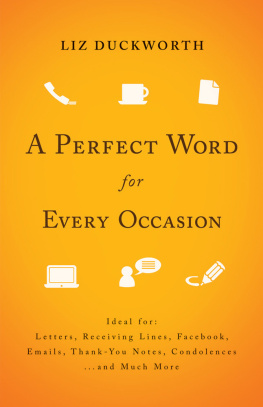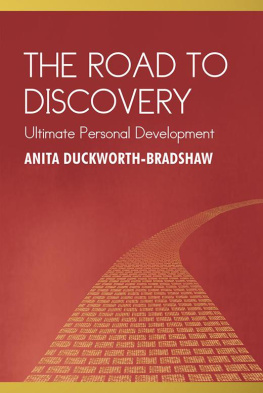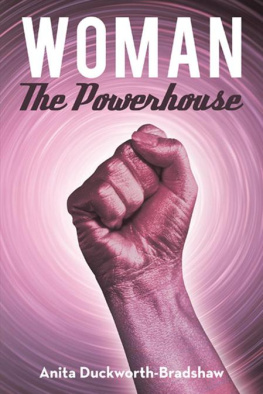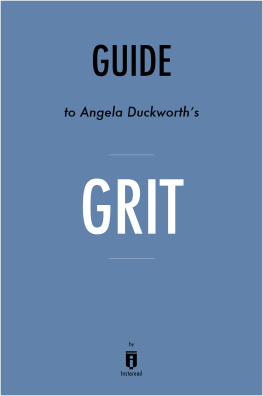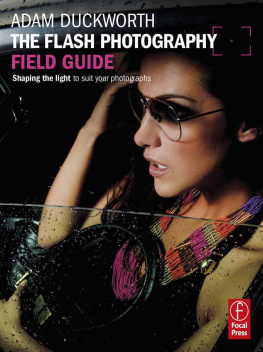
SportsBooks Limited
Copyright Frank Duckworth and Tony Lewis 2011
This ebook edition first published in 2011
The right of Frank Duckworth and Tony Lewi to be identified as author of this work has been asserted in accordance with Section 77 of the Copyright, Designs and Patents Act 1988
This ebook is copyright material and must not be copied, reproduced, transferred, distributed, leased, licensed or publicly performed or used in any way except as specifically permitted in writing by the publishers, as allowed under the terms and conditions under which it was purchased or as strictly permitted by applicable copyright law. Any unauthorised distribution or use of this text may be a direct infringement of the authors and publishers rights, and those responsible may be liable in law accordingly
ISBN 9781907524271
Cover designed by Alan Hunns.
Acknowledgements
The Duckworth/Lewis method was developed in part at the University of the West of England and is the property of the International Cricket Council (ICC).
Foreword
THIS BOOK TELLS the story of how the two of us, mathematically inclined individuals previously unknown to each other, came together to invent a solution to a problem that had baffled crickets administrators since limited-overs cricket started to be played in the 1960s. The solution we arrived at has become known as The Duckworth/Lewis method and it is now used all over the world, not only at all levels of the professional game but often in the recreational game as well.
Although it is generally admitted to work well, youd think, judging from the many comments on TV and radio and in the press, that the Duckworth/Lewis method was one of the most mathematically complex and incomprehensible systems ever devised.
It is no such thing. The mathematics are very simple and straightforward and anyone, apart from the totally innumerate, can easily understand how it works if they are prepared to make just a little effort.
But it is mathematical. It had to be mathematical because how to reset targets in a one-day cricket match where overs were lost to the weather was a mathematical problem and so it required a mathematical solution.
We have spent all our working lives in science and mathematics, and most of the problems we have had to deal with have been mathematical, at least in part. But those for whom we worked were also educated in science and mathematics and to them mathematical solutions to problems were expected.
The world of cricket, however, is not made up of scientists and mathematicians and to many users or reporters of our method, what we regard as very simple concepts are totally foreign. The concept of a two-factor relationship, second nature to ourselves, is quite alien to most TV commentators or press reporters. They can appreciate that the runs that can be scored from any point in a limited-overs innings depend on both how many overs remain and how many wickets are in hand, but they have difficulty realising that the effects of these two factors cannot simply be added one to the other; they are interdependent. So they must be described by a mathematical formula which shows how the effect of overs remaining depends on the number of wickets that are in hand and how the effect of wickets in hand depends on the number of overs still to come.
In this book we shall endeavour to explain the method in the simplest of terms. We will also tell the full story of why our method was needed, how it came about and how it gradually became accepted as the fairest and most practical way of producing a satisfactory result in rain-affected matches. We shall describe the problems we faced and our deliberations which led to the method being as it is. We shall tell of the reactions of players, officials, spectators and reporters and we shall relate the catastrophes for teams that fell foul of it.
Even if, having read the book cover to cover, you still find the method confusing, all we ask is that you dont blame us for introducing mathematics into the game. If you were in France and inadvertently contravened some local rule or regulation, you wouldnt blame the French for the fact that the rules were written in French. French is their language, and you would either try to translate into English or you would accept the fact that French rules are written in French and respect the consequences.
We promise that you will not need to be a mathematician to understand what we shall have to say. There will be mathematics, it is true, but you will easily be able to pass over the mathematical bits without losing the plot.
We think it is a fascinating story, one that we have enjoyed telling, and we trust that you will find it interesting, stimulating and, not least, entertaining.
Frank Duckworth and Tony Lewis
April 2011
Chapter 1
Frank Duckworths story
I WAS BORN in Lytham St Annes, Lancashire, soon after the outbreak of the Second World War and I was six years old before any cricket was played at national level. My first real memory of the game was the 1948 visit of The Invincibles when I recall my grandfather remarking that Englands primary object was to get that man Bradman out.
My favourite player was Denis Compton. My sister June, five years older, had a crush on him. Looking back I suspect that this was because he was particularly good looking and his picture appeared in all the papers advertising Brylcreem. The first innings of his I remember was at the first Test at Trent Bridge when he fell on his stumps after making 184.
I loved playing cricket, especially batting, but I lacked the coordination to be successful. Most of my early cricket was played on the corner field with a pile of jackets replacing the stumps. The development of my real interest in the game was largely due to a school friend, George Mills. In his back yard, using a worn-out tennis ball, and with three stumps drawn on the garage door, we simulated matches between real teams. One run was scored for returning the ball to the bowler, two for it passing the bowler, four for reaching the front gate, and six for hitting the front gate on the full toss or clearing it. If the ball went over the side partition wall and hit Mrs Bents landing window next door, it was six and out.
We used to cycle to Stanley Park, Blackpool, to watch Lancashire when they played their one match of the season there. And during a WashbrookIkin opening century partnership we took out our notebooks and drew a line showing the balls path for every run they scored maybe we were the original inventors of the wagon wheel?
Despite this enthusiasm, my ability never improved. Whereas George was to go on to become opening bat for our school, King Edward VII, Lytham, I never progressed beyond representing my junior school house. My highest score was, and remains, 11 not out. So when I left school to go to Liverpool University, my interest in cricket was purely as a spectator and as an avid listener to John Arlott, Rex Alston and those that followed. I was purely an armchair cricketer.
At school, my best subject had always been maths. But I had been advised that one could not make a career from it, so it was physics I studied at Liverpool. After graduating I stayed on to study for a PhD. The average time for completion of a PhD in physics was between five and six years, but in metallurgy it took no longer than three. So it was metallurgy to which I turned.
This was a terrible mistake. I had an awful research project, under-funded and ill-conceived, and I never took to metallurgy. But in successfully managing to interpret some very sparse results, the seeds were sown for my eventually becoming a statistical analyst.
Next page

